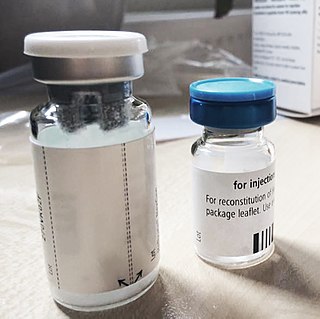Related Research Articles
In the 1980s, between one and two thousand haemophilia patients in Japan contracted HIV via contaminated blood products. Controversy centered on the continued use of non-heat-treated blood products after the development of heat treatments that prevented the spread of infection. Some high-ranking officials in the Ministry of Health and Welfare, executives of the manufacturing company and a leading doctor in the field of haemophilia study were charged for involuntary manslaughter.

Taiwan's epidemic of HIV/AIDS began with the first case reported in December 1984. On 17 December 1990 the government promulgated the AIDS Prevention and Control Act. On 11 July 2007, the AIDS Prevention and Control Act was renamed the HIV Infection Control and Patient Rights Protection Act.

AIDS, caused by the human immunodeficiency virus (HIV), has become a global health issue, and various ways are being explored in order to combat the spread of the disease. One such way to somewhat limit the spread of AIDS is through education. Societies with significant number of HIV positive individuals and people that have been diagnosed with having cases of AIDS are societies in which education about the disease is limited to almost non-existent and where culture and tradition clash with modern medicine. Thus, education and training are of great importance and a number of organizations have been formed within the past two decades. Organizations vary from being government funded to private and/or are formed by health and social advocates. Organizations provide range of services from support for families and individuals affected by the disease, classes in academic settings ranging from preschools to universities, available resources to updates on the latest advances in medical treatments.

In 2008, 4.7 million people in Asia were living with human immunodeficiency virus (HIV). Asia's epidemic peaked in the mid-1990s, and annual HIV incidence has declined since then by more than half. Regionally, the epidemic has remained somewhat stable since 2000.
HIV/AIDS in China can be traced to an initial outbreak of the human immunodeficiency virus (HIV) first recognized in 1989 among injecting drug users along China's southern border. Figures from the Chinese Center for Disease Control and Prevention, World Health Organization, and UNAIDS estimate that there were 1.25 million people living with HIV/AIDS in China at the end of 2018, with 135,000 new infections from 2017. The reported incidence of HIV/AIDS in China is relatively low, but the Chinese government anticipates that the number of individuals infected annually will continue to increase.
Contaminated hemophilia blood products were a serious public health problem in the late 1970s up to 1985.
In April 1991, the doctor and journalist Anne-Marie Casteret published an article in the French weekly magazine the L'Événement du jeudi showing that the Centre National de Transfusion Sanguine knowingly distributed blood products contaminated with HIV to haemophiliacs in 1984 and 1985, leading to an outbreak of HIV/AIDS and hepatitis C in numerous countries. It is estimated that 6,000 to 10,000 haemophiliacs were infected in the United States alone. In France, 4,700 people were infected, and over 300 died. Other impacted countries include Canada, Iran, Iraq, Ireland, Italy, Japan, Portugal, and the United Kingdom.

The situation with the spread of HIV/AIDS in Russia is described by some researchers as an epidemic. The first cases of human immunodeficiency virus infection were recorded in the USSR in 1985-1987. Patient zero is officially considered to be a military interpreter who worked in Tanzania in the early 1980s and was infected by a local man during sexual contact. After 1988—1989 Elista HIV outbreak, the disease became known to the general public and the first AIDS centers were established. In 1995-1996, the virus spread among injecting drug users (IDUs) and soon expanded throughout the country. By 2006, HIV had spread beyond the vulnerable IDU group, endangering their heterosexual partners and potentially the entire population.
The history of HIV/AIDS in Australia is distinctive, as Australian government bodies recognised and responded to the AIDS pandemic relatively swiftly, with the implementation of effective disease prevention and public health programs, such as needle and syringe programs (NSPs). As a result, despite significant numbers of at-risk group members contracting the virus in the early period following its discovery, Australia achieved and has maintained a low rate of HIV infection in comparison to the rest of the world.
HIV/AIDS is considered the deadliest epidemic in the 21st century. It is transmitted through sex, intravenous drug use and mother-to-child transmission. Zambia is experiencing a generalized HIV/AIDS epidemic, with a national HIV prevalence rate of 11.3% among adults ages 15 to 49 as of 2018. Per the 2000 Zambian census, the people affected by HIV/AIDS constituted 15% of the total population, amounting to one million, of which 60% were women. The pandemic results in increased number of orphans, with an estimated 600,000 orphans in the country. It was prevalent more in urban areas compared to rural and among all provinces, Copperbelt Province and Lusaka Province had higher occurrence.
HIV/AIDS in Bolivia has a less than 1 percent prevalence of Bolivia's adult population estimated to be HIV-positive. Bolivia has one of the lowest HIV prevalence rates in the Latin America and Caribbean region.
In 2016, the prevalence rate of HIV/AIDS in adults aged 15–49 was 0.3%, relatively low for a developing country. This low prevalence has been maintained, as in 2006, the HIV prevalence in Mexico was estimated at around 0.3% as well. The infected population is remains mainly concentrated among high risk populations, men who have sex with other men, intravenous drug users, and commercial sex workers. This low national prevalence is not reflected in the high-risk populations. The prison population in Mexico, faces a fairly similar low rate of around 0.7%. Among the population of prisoners, around 2% are known to be infected with HIV. Sex workers, male and female, face an HIV prevalence of around 7%. Identifying gay men and men who have sex with other men have a prevalence of 17.4%. The highest risk-factor group is identifying transgender people; about 17.4% of this population is known to be infected with HIV. Around 90% of new infections occur by sex-related methods of transmission. Of these known infected populations, around 60% of living infected people are known to be on anti-retroviral therapy (ART).
The HIV/AIDS epidemic in Ukraine is one of the fastest-growing epidemics in the world. Ukraine has one of the highest rates of increase of HIV/AIDS cases in Eastern Europe and highest HIV prevalence outside Africa. Experts estimated in August 2010 that 1.3 percent of the adult population of Ukraine was infected with HIV, the highest in all of Europe. Late 2011 Ukraine numbered 360,000 HIV-positive persons. Between 1987 and late 2012 27,800 Ukrainians died of AIDS. In 2012 tests revealed 57 new cases of HIV positive Ukrainians each day and 11 daily AIDS-related deaths.

With an estimated 150,000 people living with HIV/AIDS in 2016, Haiti has the most overall cases of HIV/AIDS in the Caribbean and its HIV prevalence rates among the highest percentage-wise in the region. There are many risk-factor groups for HIV infection in Haiti, with the most common ones including lower socioeconomic status, lower educational levels, risky behavior, and lower levels of awareness regarding HIV and its transmission.

The contaminated blood scandal, also known as the infected blood scandal, is a British medical scandal in which a large number of people were infected with hepatitis C and HIV, as a result of receiving contaminated blood or contaminated clotting factor products. Many of the products were imported from the US, and distributed to patients by the National Health Service throughout the 1970s and 1980s. Most recipients had haemophilia or had received a blood transfusion following childbirth or surgery. It has been estimated that more than 30,000 patients received contaminated blood, resulting in the deaths of at least 3,000 people. In July 2017, Prime Minister Theresa May announced an independent public inquiry into the scandal, for which she was widely praised as successive governments going back to the 1980s had refused such an inquiry. May stated that "the victims and their families who have suffered so much pain and hardship deserve answers as to how this could possibly have happened." The final report was published in seven volumes on 20 May 2024, concluding that the scandal could have been largely avoided, patients were knowingly exposed to "unacceptable risks", and that doctors, the government and NHS tried to cover-up what happened by "hiding the truth".

North Korea has a life expectancy of 72 years as of 2020. While North Korea is classified as a low-income country, the structure of North Korea's causes of death (2013) is unlike that of other low-income countries. Rather, causes of death are closer to the worldwide averages, with non-communicable diseases – such as cardiovascular disease – accounting for two-thirds of the total deaths.
Discrimination against people with HIV/AIDS or serophobia is the prejudice, fear, rejection, and stigmatization of people with HIV/AIDS. Marginalized, at-risk groups such as members of the LGBTQ+ community, intravenous drug users, and sex workers are most vulnerable to facing HIV/AIDS discrimination. The consequences of societal stigma against PLHIV are quite severe, as HIV/AIDS discrimination actively hinders access to HIV/AIDS screening and care around the world. Moreover, these negative stigmas become used against members of the LGBTQ+ community in the form of stereotypes held by physicians.
HIV/AIDS in Japan has been recognized as a serious health issue in recent years. However, overall awareness amongst the general population of Japan regarding sexually transmitted infections, including HIV/AIDS, remains low.

The HIV Haemophilia Litigation [1990] 41 BMLR 171, [1990] 140 NLJR 1349 (CA), [1989] E N. 2111, also known as AMcG002, and HHL, was a legal claim by 962 plaintiffs, mainly haemophiliacs, who were infected with HIV as a result of having been treated with blood products in the late 1970s and early 1980s. The first central defendants were the then Department of Health, with other defendants being the Licensing Authority of the time, (MCA), the CSM, the CBLA, and the regional health authorities of England and Wales. In total, there were 220 defendants in the action.
The Irish Haemophilia Society (IHS) is an organization that represents the interests of people with haemophilia, von Willebrand disease and other inherited bleeding disorders.
References
- ↑ POZ - News : Iraq’s First HIV Lawsuit
- ↑ "AEGiS-AFP News: Iraq-AIDS-Saddam: HIV-infected haemophiliac brothers pay for father's Saddam handshake - May 8, 2003". Archived from the original on 2012-02-14. Retrieved 2008-12-28.
- ↑ "One of world's worst countries for mothers". 7 May 2003.
- ↑ "HIV-positive persons fear reprisals". 14 January 2009.
- ↑ "Western Resistance: Iraq: Couple Murdered for Being HIV Positive; Islam Absolved". Archived from the original on 2011-07-18. Retrieved 2007-02-22.
- ↑ "Aid & Development: AIDS in Iraq: "Men here believe they are immune to the disease"". Archived from the original on 2007-06-10. Retrieved 2007-02-22.
- ↑ FHI – Iraqi Study Tour
- ↑ "Aid & Development: Health officials in Iraq ordered to deport HIV-positive foreigners". Archived from the original on 2007-06-10. Retrieved 2007-02-22.
- ↑ Taboo on topic of AIDS handicaps health care / Low caseload makes getting affordable medications difficult